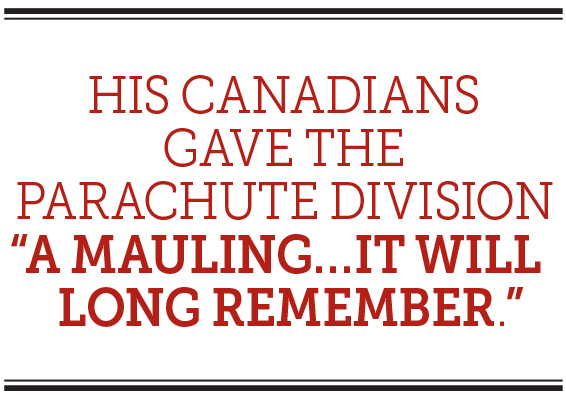
From Left: 1st Fallschirmjager Division paratroopers with a Mauser MG 42 in Italy in 1943. Right: 1st Canadian Infantry Division soldiers on a self-propelled howitzer in Italy in 1944. [Wikimedia / DND/LAC/PA – 184998]
On July 10, 1943, the 1st Canadian Infantry Division—about 18,000 men—stormed ashore in Sicily as part of Operation Husky and filed into the island’s mountainous heart. The division had been the first Canadians to deploy to Britain in December 1939. Now they marched to battle. As they pushed toward Mount Etna, German resistance stiffened, but their unflagging tenacity prompted the Germans to nickname them the “Red Patch Devils” after their divisional shoulder patches.
The first brush with the 1st Fallschirmjäger Division—Germany’s elite paratroopers—came on Aug. 2, when the 3rd Brigade’s West Nova Scotia Regiment was repulsed at Mount Criscina by the German division’s 3rd Regiment in a bloody clash that cost Canada 19 lives and 26 wounded. Several more bitter firefights between the Canadians and paratroopers followed, but nothing of divisional scale before the Allies won Sicily.
The first division-versus-division showdown came when the paratroopers relieved the 90th Panzer Grenadier Division on Dec. 13,1943, at the Gully and then slugged it out with the Canadians in and around Ortona. Despite having been in constant combat since Dec. 6 and having suffered heavy casualties, the Canadians persevered and denied the paratroopers a desired stalemate. During the night of Dec. 27-28, the German division withdrew from Ortona’s ruins.
Roles reversed in May 1944, when the Canadians deployed in the Liri Valley to breach the Hitler Line. Again they faced the paratroopers, who had been badly chewed up in months of previous fighting defending Monte Cassino. However, during a set-piece attack on May 23, the heavily entrenched Germans tore the 2nd Infantry Brigade asunder. But the 3rd Infantry Brigade shattered the German defences in front of it and again the paratroopers had to retreat.
A rematch came on Aug. 25, when the Red Patch Devils crossed the Metauro River in a drive toward the last major German defences in Italy—The Gothic Line. Some Allied journalists declared the paratrooper division to be the best in any army—Allied or enemy. Major-General Christopher Vokes heatedly refuted this, pointing out that whenever the 1st Infantry Division “met the parachutists, the latter had the worst of it.”
A hard, bludgeoning fight running to Sept. 6 and the fall of Rimini proved his case.

January 1945 found the 1st Infantry Division facing the 1st Fallschirmjäger Division across the Senio River outside Ravenna. Another slugging match ensued that ended with the Germans again retreating after both sides suffered heavy casualties. But again, the Red Patch Devils stood victorious.
In April 1943, Germany’s 1st Fallschirmjäger Division was formed from elements of the 7th Flieger Division, which had fought in almost every German theatre of war since the September 1939 invasion of Poland. Consequently, most of the division’s paratroopers were hardened veterans—earning the nickname “Green Devils” early in the war.
Stationed in Avignon, France, when the Allies invaded Sicily on July 10, the division immediately deployed to Italy. On July 12, one of its three regiments jumped onto an airfield outside Catania to block the British Eighth Army’s advance. Within 45 minutes, 1,400 paratroopers were ready for action. As the rest of the division arrived, it was organized into a fire brigade with elements racing to wherever the fighting was hottest. This was a familiar role for the paratroopers and one at which they excelled. As the campaign turned against the Germans, the division served as a rearguard covering the retreat and were the last to leave the island on Aug. 17.
The division continued its fire-brigade role in Italy with a piecemeal deployment against the United States Fifth Army landings at Salerno.
In December, they raced across the Apennine Mountains to prevent the 1st Canadian Infantry Division from seizing Ortona. After withdrawing on the night of December 27-28, German Corporal Karl Bayerlein wrote: “The enemy gained a destroyed city. We left undefeated.” Major-General Christopher Vokes boasted that his Canadians gave the parachute division “a mauling…it will long remember.” The Germans did remember, and considered the Canadians to be Eighth Army’s shock troops. Whenever the Canadians appeared in future engagements, a bitter battle was assured.

After Ortona, the paratroopers deployed to Monte Cassino in defence of the German Gustav Line. Here they engaged in fierce fighting from January to May 1944, being pitted variously against American, Polish, Indian, British, New Zealand and, finally, Canadian troops. In March, at the height of the 1st Fallschirmjäger’s defence amid the ruins of the Abbey of Monte Cassino, Field Marshal Harold Alexander told Winston Churchill that he doubted “there are any troops in the world who could have…gone on fighting with the ferocity they have.”
Withdrawing to the Gothic Line, the division again tried unsuccessfully to stem a Canadian breakthrough on the Adriatic coast. It then fell back to the rivers near Ravenna for a final battle with the Canadians. On May 2, 1945, the paratroopers surrendered along with all other German forces in Italy.
Advertisement




















